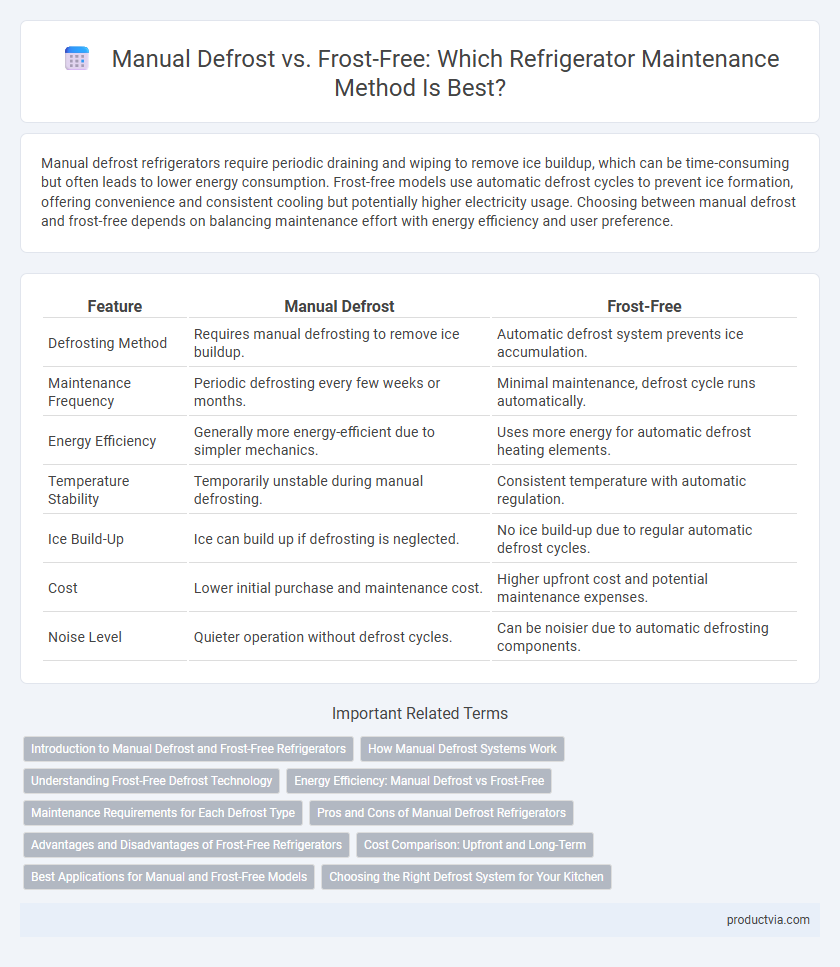Manual defrost refrigerators require periodic draining and wiping to remove ice buildup, which can be time-consuming but often leads to lower energy consumption. Frost-free models use automatic defrost cycles to prevent ice formation, offering convenience and consistent cooling but potentially higher electricity usage. Choosing between manual defrost and frost-free depends on balancing maintenance effort with energy efficiency and user preference.
Table of Comparison
| Feature | Manual Defrost | Frost-Free |
|---|---|---|
| Defrosting Method | Requires manual defrosting to remove ice buildup. | Automatic defrost system prevents ice accumulation. |
| Maintenance Frequency | Periodic defrosting every few weeks or months. | Minimal maintenance, defrost cycle runs automatically. |
| Energy Efficiency | Generally more energy-efficient due to simpler mechanics. | Uses more energy for automatic defrost heating elements. |
| Temperature Stability | Temporarily unstable during manual defrosting. | Consistent temperature with automatic regulation. |
| Ice Build-Up | Ice can build up if defrosting is neglected. | No ice build-up due to regular automatic defrost cycles. |
| Cost | Lower initial purchase and maintenance cost. | Higher upfront cost and potential maintenance expenses. |
| Noise Level | Quieter operation without defrost cycles. | Can be noisier due to automatic defrosting components. |
Introduction to Manual Defrost and Frost-Free Refrigerators
Manual defrost refrigerators require users to periodically thaw ice buildup to maintain optimal performance, which involves extra effort but can save energy over time. Frost-free refrigerators use automatic defrost systems with heating elements to prevent ice accumulation, enhancing convenience and consistent cooling efficiency. Choosing between these types depends on maintenance preferences, energy consumption, and climate conditions impacting ice formation.
How Manual Defrost Systems Work
Manual defrost refrigerators operate by periodically shutting off the cooling system to allow accumulated frost to melt naturally, preventing ice buildup on the evaporator coils. Users must manually remove the melted water using a drain or cloth, requiring regular maintenance to ensure optimal cooling performance. This system relies on the user's intervention to maintain efficiency and avoid potential cooling issues associated with thick ice layers.
Understanding Frost-Free Defrost Technology
Frost-free refrigerators use an automated defrosting system that prevents ice buildup by periodically heating the evaporator coils to melt frost, maintaining consistent cooling efficiency without manual intervention. This technology reduces maintenance time and energy consumption compared to manual defrost models, which require regular defrost cycles to prevent ice accumulation. Understanding frost-free defrost technology highlights its benefits in preserving food quality and enhancing appliance longevity through optimized temperature control and moisture management.
Energy Efficiency: Manual Defrost vs Frost-Free
Manual defrost refrigerators consume less energy because they lack a built-in fan or heater used to prevent ice build-up, making them more energy-efficient than frost-free models. Frost-free refrigerators periodically cycle on heaters to melt frost, increasing electricity usage and potentially raising energy bills. Choosing manual defrost models can reduce overall energy consumption and contribute to lower household energy costs.
Maintenance Requirements for Each Defrost Type
Manual defrost refrigerators require regular draining and wiping to prevent ice buildup, demanding more hands-on maintenance compared to frost-free models. Frost-free refrigerators utilize automatic defrost cycles that reduce the need for manual intervention, enhancing convenience and preventing frost accumulation. Proper upkeep of each defrost type ensures optimal cooling efficiency and prolongs appliance lifespan.
Pros and Cons of Manual Defrost Refrigerators
Manual defrost refrigerators offer energy efficiency and quieter operation since they lack the automatic defrost heater. They require regular manual defrosting to prevent ice buildup, which can be time-consuming and inconvenient. Despite lower initial costs, users must balance maintenance efforts against potential frost-related performance issues.
Advantages and Disadvantages of Frost-Free Refrigerators
Frost-free refrigerators offer the advantage of automatic defrosting, reducing the need for manual maintenance and preventing ice buildup, which ensures consistent cooling efficiency and saves time. However, they tend to consume more energy compared to manual defrost models due to the continuous operation of fans and heaters. The complexity of frost-free systems can lead to higher repair costs and potential mechanical failures over time.
Cost Comparison: Upfront and Long-Term
Manual defrost refrigerators generally have lower upfront costs and consume less energy, resulting in reduced long-term expenses compared to frost-free models. Frost-free refrigerators, while initially more expensive, offer convenience with automatic defrost systems that eliminate the need for manual thawing and reduce maintenance time. Over the lifespan of the appliance, energy efficiency and repair frequency must be considered to determine the most cost-effective option for individual needs.
Best Applications for Manual and Frost-Free Models
Manual defrost refrigerators are best suited for small, budget-conscious households or locations with limited electricity access due to their energy efficiency and simple maintenance. Frost-free models excel in larger homes or environments with high humidity, offering convenience by preventing ice buildup and reducing the need for manual defrosting. Choosing between manual and frost-free depends on usage patterns, energy considerations, and maintenance preferences.
Choosing the Right Defrost System for Your Kitchen
Manual defrost refrigerators require periodic ice removal, providing energy efficiency and quieter operation ideal for small kitchens or low usage scenarios. Frost-free models use an automatic defrost system, preventing ice buildup and minimizing maintenance, making them suitable for busy households and larger family kitchens. Selecting the right defrost system depends on balancing convenience, energy consumption, and space requirements to optimize refrigerator performance in your kitchen.
Manual defrost vs frost-free for refrigerator maintenance Infographic

 productvia.com
productvia.com